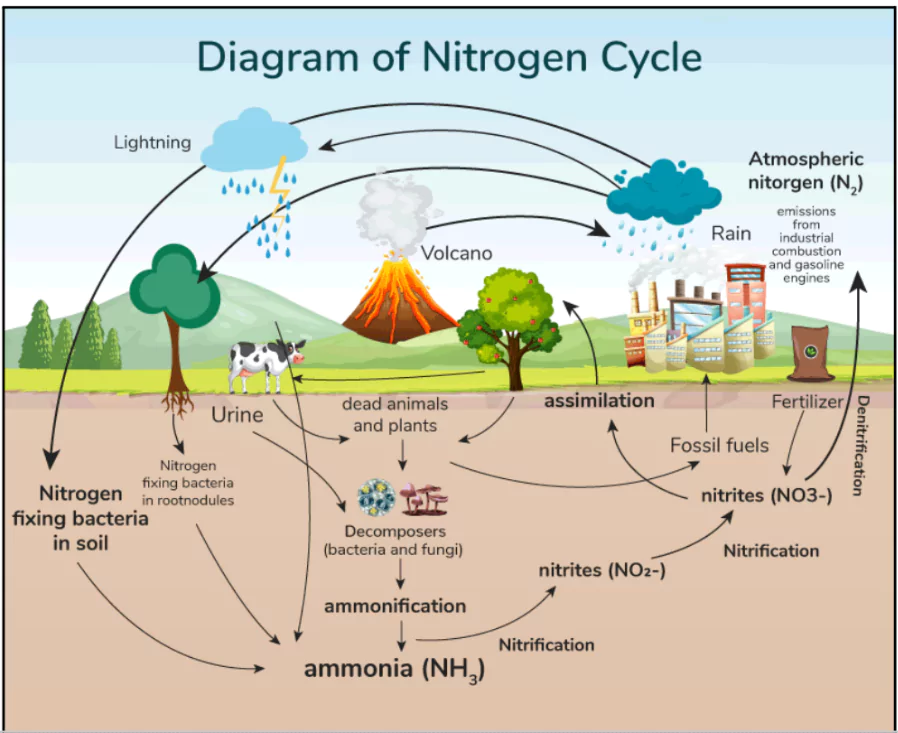A recent report by the Food and Agriculture Organization (FAO) highlights the alarming rise in nitrogen pollution.
Key Findings of the Report
- Rising Emissions: Humans add 150 teragrammes (Tg) of reactive nitrogen annually, projected to reach 600 Tg/year by 2100 due to climate change.
- Nitrogen Use Efficiency (NUE): Global NUE declined from 56% (1961) to 40% (1980s) and rebounded to 56% by 2022.
- Main Contributors: Livestock emissions account for one-third of total nitrogen emissions, along with synthetic fertilizers, land-use changes, and manure.
- Regional Impact: Nitrogen pollution is most severe in North America, Western Europe, and parts of Asia due to extensive fertilizer misuse.
- Crop Variations: NUE varies by crop, e.g., soybeans (80%) vs. fruits/vegetables (14% in 2010).
Enroll now for UPSC Online Course
About Nitrogen
- Nitrogen in the Atmosphere: Nitrogen constitutes 78% of Earth’s atmosphere, but this nitrogen exists in an inert form that most organisms cannot utilize.
Nitrogen Use Efficiency (NUE)
- Nitrogen use efficiency refers to the yield of a crop relative to the nitrogen (natural and artificial) available to it.
- It is defined as the ratio of the amount of nitrogen effectively utilised by crops to the amount of nitrogen applied. It measures how well a plant uses nitrogen for growth and productivity.
|
- Reactive Nitrogen: Through natural processes like nitrogen fixation by legumes and industrial methods (e.g., the Haber-Bosch process), nitrogen becomes reactive and usable.
- The Haber-Bosch process involves the transformation of Atmospheric nitrogen (N2) into ammonia (NH3) via a reaction with hydrogen (H2).
- This process employs a metal catalyst (iron) and operates under high temperatures and pressures.
- This has significantly boosted global food production over the past century.
- Negative Impact: Human-driven nitrogen flows have increased tenfold in the last 150 years. Around 80% of reactive nitrogen is lost to the environment annually, leading to soil and water pollution, biodiversity loss, and health issues.
Sources of Nitrogen Pollution

- Agriculture: Excessive use of synthetic fertilizers.
- Livestock emissions, contributing about one-third of global nitrogen pollution.
- Mismanagement of manure.
- Industrial Activities: Emissions from factories and coal power plants.
- Vehicle Emissions: Nitrogen oxides from exhausts.
- Land-Use Change: Deforestation and habitat alteration.
Impact of Nitrogen Pollution
- Climate Change: Nitrous oxide is 300 times more potent than carbon dioxide as a greenhouse gas and has a 200-year atmospheric lifetime, contributing significantly to global warming and ozone depletion.
- Biodiversity Loss: Over-fertilization of ecosystems, causing sensitive species to be outcompeted.
- Creation of oceanic “dead zones” and toxic algal blooms.
- Health Risks: Ground-level ozone and smog caused by nitrogen oxides lead to respiratory diseases.
- Dangerous particulates from agricultural ammonia emissions exacerbate health conditions.
- Economic Costs: The annual cost of nitrogen resource losses is estimated at $200 billion globally.
International Efforts to Control Nitrogen Pollution
- Colombo Declaration: A global initiative aimed at halving nitrogen waste by 2030.
-
- Encourages investment in research and sustainable practices.
- United Nations Frameworks: Integration of nitrogen management in Sustainable Development Goals (SDGs).
- Multilateral Environmental Agreements addressing nitrogen-related challenges.
- Scientific Collaboration: UNEP supports research on nitrogen sources and mitigation strategies.
Check Out UPSC Modules From PW Store
Way Forward for Addressing Nitrogen Pollution
- Promote Sustainable Agriculture: Encourage the use of organic fertilizers, biological nitrogen fixation, and precision farming to minimize nitrogen losses and enhance NUE.
- Adopt Effective Policy Frameworks: Develop region-specific policies to regulate nitrogen use, emphasizing circular bioeconomy approaches and sustainable livestock distribution.
- Enhance Industry Practices: Reduce greenhouse gas emissions during fertilizer production and improve storage, transport, and application processes to minimize waste.
- Increase Awareness and Training: Educate farmers on efficient nitrogen use, manure management, and crop rotation strategies to reduce environmental impact.
- Global Commitments: Align national goals with global frameworks like the Paris Agreement and Colombo Declaration to reduce nitrogen emissions and meet biodiversity targets.
Ready to boost your UPSC 2025 preparation? Join PW’s UPSC online courses today!
![]() 23 Jan 2025
23 Jan 2025


